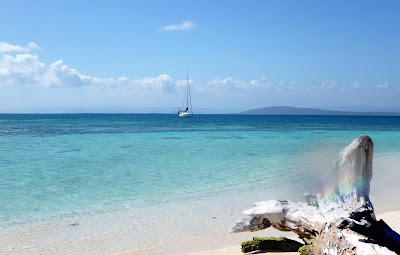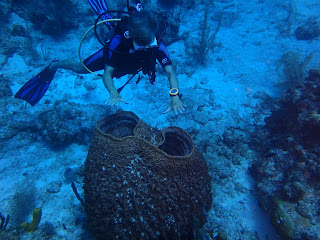 |
| Exit Strategy arrived in Jamaica at the beginning of ACKEE season! |
It was good to
be anchored and finally relaxing for an extended period and GREAT to be doing
it back in Jamaica. This was our fifth
trip to this piece of paradise, the second via sv Exit Strategy. When we cleared in, the Customs and Immigration
people gave us a “Coastwide Transpire” indicating that we wouldn’t have to
check in with officials until we reached Montego Bay.
We stayed in
Port Morant-Bowden Bay where just one other vessel entered and departed
during our visit. On an afternoon walk
along the nearby less traveled roads that were graced with all sorts of
tropical fruits, we met some locals and one Rastafarian who sold us some fruit
and a bottle of his homemade hard cider. Another day we dinghied ashore near
the village on the far side of the bay and caught a Route Taxi to Morant Bay,
the nearest large town where we could buy a SIM card for communication purposes. The taxi was similar in size to a
Corolla. When we hailed it, we didn’t see
that there were already three passengers in it- one in front and two in the
back seat. I suspect that the driver didn’t want to “dis” us white folks, so he
nodded us in. Then we didn’t want to “dis” him, so we “skinnied-up” ourselves.
I tried to balance lightly on one of Dan’s knees for what we thought might be a
short ride. It was not. For the next thirty
minutes or more, the taxi sped along a winding coastal road, veering around
people on foot and passing traffic. I tried
to focus on the landscape as it whizzed by because my life flashed before me
every time I peered forward. The return
trip in a different Route Taxi was less stressful and I had a comfortable ride
ON a seat. (RT cost was 300 JD/person =
approx.$2.23 USD)
 |
| Absolutely loved the Bob Marley Museum tour given by a guide who had us singing Marley's Reggae hits. |
 |
| Military boot camp in the Blue Mountains above Kingston |
Our next port
of call was Kingston, Jamaica’s capital. We had not intended to stop here
because of its reputation; however, Kingston had the boat services needed to
help us remedy the few things on the “fix-it” list. It was late afternoon when
we entered the seventh largest harbor in the world and the wind kicked up
fiercely, gusting at times to 33 knots- right on our nose. After motoring through wicked winds and chop
for about six miles-taking nearly 3 hours, we dropped anchor near the Royal
Jamaican Yacht Club. The folks there
were quite helpful in recommending a chandlery and arranging a reputable
driver. We were so pleased with the
driver that we also booked a full day tour to some of the sites in the city and
up into the Blue Mountains.
 |
| 93% of Jamaican Blue Mountain Coffee is shipped to Japan |
The sailing
conditions upon exiting Kingston Harbor were much calmer, so our sails flew full
and happy. Unfortunately, about two miles out of the harbor a Coast Guard boat
came alongside and ordered us back into the bay to talk with a Customs
official. We regretfully turned around
and reported to the designated dock. As it turned out, the official
misinterpreted our paperwork, made a written notation on it, and sent us on our
way.
 |
| Exit Strategy as seen from beach on Half Moon Cay near Portland Point |
The Portland
Cays are sprinkled off of Portland Point about midway on Jamaica’s southern
coast. The cays are quite small and not
more than spits of sand-covered reef with good holding in sparse turtle grass.
They are uninhabited, but frequented by fishermen. We spent a few nights anchored there in very
pleasurable solitary confinement.
 |
| Lots of sea stars strewn along Jamaica's southern coast |
Alligator Reef
was the next planned stop where we also spent a few nights. There was no sandy shore here, just enough
reef at the surface during low tide to quell the seas in the anchorage. Fishermen
gathered in the shallows nearby to net bait fish.
After Alligator
Reef, we dropped the hook in Great Pedro Bay. The remote bay is home to a small fishing co-op and it was memorable for many
reasons. Here we met a group of friendly locals whose main jobs appeared to be keeping the barstools warm at the Lobster Pot, a small seaside restaurant. One morning we took a walk in search of fresh
fruit and vegetables and were directed to take the “shortcut” instead of the
main road. The recommended trek lead through so many deserted back roads and
cow-lined lanes that we considered turning around more than once. We finally located the Rastafarian fruit vender
on the main road in the town of Treasure Island that was about 4 miles away via
the shortcut. On our return trip, we
were truly blessed when a man we had talked to on the way offered us a ride back to Great Pedro Bay in
his car!
 |
| The fishermen pull their boats ashore daily. |
Black River is Jamaica’s
longest river and is populated by crocodiles that have seen so many tour boats
that they respond to calls from operators. Here we were surprised to meet a Dutch
cruising couple we had last seen in Bonaire and shared a day of land touring
with them. While climbing around the Y S
Falls that afternoon, we encountered yet another cruising couple from
Switzerland whom we also knew from a previous season in Bonaire. Upon returning to town, we learned that, in
our absence, the coastguard had saved our dinghy from drifting off when its
painter wore through. (We had not secured it with our cable lock at the
coastguard’s request.)
 |
| Y S Falls is located on a cattle farm and appeared to be one of the most visited sites on the island. |
 |
| If I remember correctly, this croc was named Patricia. |
Bluefields was
another peaceful anchorage- at night. During
the day, many large trucks traversed the narrow coastal road moving what mainly
appeared to be building supplies. While talking
with Jamaicans in every town we visited, they voiced their concerns about the amount
of highway projects that the Chinese have been hired to complete. The Chinese ship in most of their own supplies
and laborers and the Jamaican companies cannot compete with their bids.
From Bluefields, we rounded up toward Jamaica's west coast which is the focus of the next blog entry.










































